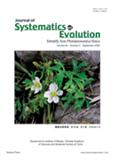De-Jun ZHANG, Sheng-Yun CHEN, Qing-Bo GAO, Yi-Zhong DUAN, Shi-Long CHEN
The largest section of the genus Saxifraga (Saxifragaceae), sect. Ciliatae, consists of 175 morphologically diverse species. This section is mainly distributed in the Qinghai-Tibetan Plateau and adjacent regions of southwest China and more than 80% of the total number of species are endemic to this region. It remains unknown whether this section is monophyletic and up to now no study has been conducted on the infra-sectional phylogeny. In this study, ITS sequences of the nuclear ribosomal DNA were firstly determined for 33 species mainly from this section and related sections. We further downloaded the corresponding sequences of the same DNA region for the other 22 species of Saxifraga and Mitella from GenBank. All sequences were together used to construct the phy-logenetic trees. The main implications of the phylogenetic analyses include: (1) sect. Ciliatae, as traditionally defined, constitutes as a monophyletic clade and its sister group is a well supported clade that includes species from 8 sections such as sect. Porphyrion, sect. Saxifraga and sect. Mesogyne; (2) three morphological subsections, i.e., subsect. Gemmiparae, subsect. Hirculoideae and subsect. Rosulares were tentatively recovered despite the relatively low statistic bootstrap support for the last one; however, subsect. Flagellares and subsect. Hemi-sphaericae were not recognized as separate entities, and nested within subsect. Gemmiparae; (3) subsect. Hircu-loideae and subsect. Rosulares clustered together as sister subclades while subsect. Gemmiparae diverged early. In addition, our results suggest that the paired variation of ITS sequences in sect. Ciliatae is relatively low between the sampled species in spite of their diverse morphology. It is suggested that such a scenario may mirror rapid speciation in this section that probably trigged by the uplifts of the Qinghai-Tibetan Plateau and the extensive selection pressure under the alpine environments.

